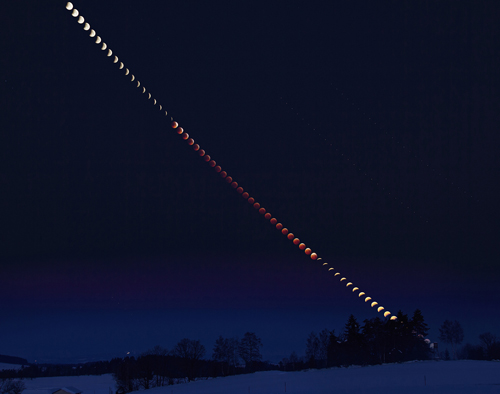Last year’s so-called super blood wolf moon gave astronomers the chance to measure the spectrum of Earth’s atmosphere as if it were a transiting exoplanet, a feat that is possible only during a total lunar eclipse.
“It’s a very fascinating thought to imagine that the spectrum of Earth is always broadcast to the outside,” said Matthias Mallonn, a postdoctoral researcher at Leibniz Institute for Astrophysics Potsdam in Germany. Mallonn and other researchers on the project typically hunt for faint spectral signals from the atmospheres of distant worlds, but the lunar eclipse let them look at Earth instead.
During the 21 January 2019 total lunar eclipse, the researchers used one of the largest visible-light telescopes on Earth to measure the spectrum of sunlight that had passed through the top of Earth’s atmosphere. That light bore signals from molecular oxygen and water vapor and also sodium, potassium, and calcium. This is the first time this method has been used to spot those three elements in Earth’s atmosphere.
“Exoplanets are truly alien worlds and typically have very different properties from the solar system planets,” said Eliza Kempton, an assistant professor of astronomy at the University of Maryland in College Park who was not involved with this research. “We must first establish what the Earth and other solar system planets look like ‘as exoplanets’ to benchmark our understanding of the far more exotic extrasolar planets.”
Lunar Eclipse Mimics a Transit
One way that astronomers can measure the chemical composition of exoplanet atmospheres is called transmission spectroscopy, which captures starlight that has passed through a planet’s atmosphere. The atmosphere imprints a chemical signature on the starlight that can reveal major components like water, methane, or even metal oxides. So far, most of these measurements have been done for large, gaseous planets that orbit close to their stars.
Future telescopes will allow similar measurements of Earth-sized planets in the habitable zones of their host stars, and the researchers wanted first to test this out on Earth. Fortunately, the positions of the Sun, Earth, and Moon during total lunar eclipse mirror the geometric setup needed for this: the Sun as the distant star, the Earth as the exoplanet, and the Moon as the far-off observer, Mallonn explained.

However, there is no telescope on the Moon waiting to capture the transmitted light. Instead, the team measured that light after it reflected from Tycho Crater. That light then entered our atmosphere and was observed by the Large Binocular Telescope (LBT) over a roughly 4-hour period. After accounting for the spectra of sunlight, the lunar surface, and contamination from traveling to the telescope on the ground, the team was left with the signal as it appeared when the light passed through Earth’s atmosphere.
Earth’s transmission spectrum showed strong signals from molecular oxygen and from water, both important biosignatures. Sodium, calcium, and potassium also appeared in Earth’s transmission spectrum, and all three elements have been detected in the atmospheres of hot Jupiter exoplanets. These results will be published in a future issue of Astronomy and Astrophysics.
“The entire exercise was not to learn something new about the Earth’s atmosphere,” Mallonn said, “but to prove the technique and check out how well we can actually get to the biosignature features, the molecules that might be indicative of life.”
“Studies such as this one, which observe solar system planets as if they were exoplanets—i.e., using the same types of observational techniques and/or observing geometry—are vital for our understanding of exoplanet atmospheres,” Kempton said.
Awaiting Future Telescopes
Mallonn acknowledged that a lunar eclipse isn’t a perfect analogue to what astronomers could expect to see from a transiting exoplanet. During a total lunar eclipse, an observer on the Moon would see the entire Sun blocked by the Earth, but a transiting exoplanet blocks only a small fraction of its host star. The atmospheric signal from such an exoplanet would be much weaker than what the team observed for Earth, he said.
At the moment, “if we were in the situation where we found an Earth-sized planet around a Sun-like star, the LBT could hardly do anything about it,” he said. “We would have to wait another 10 years for the next generation of ground-based telescopes with much larger mirror sizes and much larger apertures.” Some of those telescopes, such as the European Extremely Large Telescope and the Thirty Meter Telescope, are currently in development and are expected to play a crucial role in detecting signs of life on exoplanets, Mallonn said.
Moreover, molecular oxygen and water aren’t the most convincing of biosignatures. Methane, ozone, and a host of gases are more suggestive of life. However, the most persuasive biosignatures produce signals at longer infrared wavelengths that are difficult to measure beneath Earth’s atmosphere, which absorbs much of that light in what’s called a telluric spectrum.
“In the infrared, the space telescopes have the strong advantage of not being affected by the telluric component of the spectrum,” Mallonn said. The James Webb Space Telescope is expected to fill that role.
“It’s rather simple to see that there’s life on Earth,” he said. “If another civilization living out there takes a spectrum of the Earth, then [it’ll] actually see by our own biosignature molecules that there is life…and I just hope that in another 30 years or whenever, we might be able to do a similar observation of another planet.”
—Kimberly M. S. Cartier (@AstroKimCartier), Staff Writer






